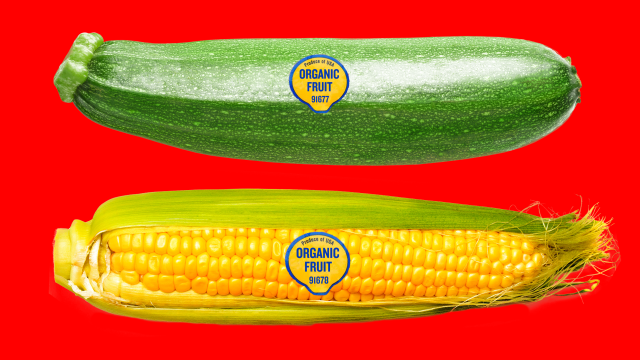If you think you’re a smartypants because you know a tomato is a fruit, buckle up. You’re right, but a tomato is also a vegetable. And rice is a fruit. And some of the things you think are fruits — strawberries, for example — aren’t actually what they seem.
Photo Illustration by Elena Scotti/Lifehacker/GMG, photos via Shutterstock
‘Vegetable’ Is Not a Scientific Term
Before we get into what a fruit is, we need to talk about vegetables. You won’t open up a botany textbook and find anything about vegetables; it’s just a term that we non-scientists use to describe our food. Merriam-Webster has a typical definition:
a usually herbaceous plant (such as the cabbage, bean, or potato) grown for an edible part that is usually eaten as part of a meal; also: such an edible part
I asked our own Claire Lower how she would define a vegetable, and she said “a plant part that is usually used in savoury applications, and doesn’t have a sweet flavour”.
Note that the way we use the term in the kitchen isn’t the same way we’d use it in a nutrition analysis. Potatoes are starchy, so I’d consider them an alternative to other starchy foods (such as bread, rice and pasta). If I’m asking my kids to eat their vegetables, I don’t think a bowl of mashed potatoes would qualify. So is a potato a vegetable? Yes and no.
Glad we cleared that up.
What Is a Fruit?
There are multiple definitions of fruit. First is the one that you know when you see: Apples, peaches, raspberries and so on. They typically have seeds and taste sweet. That’s the culinary definition.
But fruit is also a technical term to biologists. Just grab your nearest botany textbook — we all have one, right? — and you’ll see that a fruit is:
In angiosperms, the structure that forms from carpels and associated tissues after fertilisation.
Angiosperms are flowering plants. The carpel is the ovary, which you can often see or feel as a lump at the base of a flower. That means that a fruit is what a fertilised flower turns into.
You may have heard that a fruit is anything with seeds inside. It’s true that just about anything with seeds is a fruit, so that includes apples (many seeds), peaches (one seed) and bananas (brown specks where seeds should be, but aren’t, thanks to some weird natural mutations). The botanical definition of fruit also includes a lot of things we think of as vegetables: Not just tomatoes, but also eggplants, peppers, avocados, cucumbers and pumpkins.
Take note: A fruit can also be a vegetable. You can pester your friends by saying, “Hey, did you know zucchini is a fruit?” and you’ll be correct. But if you say, “Actually, zucchini is a fruit, not a vegetable,” you will be wrong and they will be within their rights to smack you. It’s both.
These Are Also Fruits
Now it’s time for the advanced level in fruit and vegetable pedantry: The things that are fruits, botanically speaking, but that don’t fit our mental image of something juicy with seeds inside.
An ear of corn has seeds inside, if you think about it: The kernels. Each kernel is actually its own fruit. You know the corn silk? Those annoying strands that stick out of the ear like a tuft and get stuck in your teeth if you don’t clean them all off? Each of those is a tunnel for pollen to travel from the outside world down to the little tiny flower-like thing that becomes a corn kernel. If one of the strands doesn’t get pollinated, its kernel won’t develop, and you get a sort of empty space on the ear of corn.
Beans and peas come from fruit, too. Specifically, their pod is the fruit, and the beans or peas are the seeds inside.
Grains, including rice, wheat and oats, are also fruits. The fruit’s skin is fused to the seed, so there isn’t a fleshy part like in a peach. The seed and the fruit are basically the same thing. (The technical term for this is a caryopsis.)
Nuts are fruits. Don’t believe me? Go find a tree that makes nuts. I have a black walnut in my yard. It makes green tennis-ball looking fruits, and inside that fruit is a pit. The pit is actually a walnut in its shell.
Strawberry seeds are fruits. Each one develops from a separate stamen (female flower part) inside of one many-stamened strawberry flower. The fruits mature while they grow a delicious blob of flesh to hold them together. (Raspberries and blackberries are a similar package deal, but without a big edible blob in the middle.) In the kitchen, we call that red blob a fruit, but to botanists it is a “fleshy receptacle” or an “accessory fruit”.
May I blow your mind? If you want to get really pedantic about berries, they are fruits that have a fleshy wall, seeds but no stone, and develop from a single ovary. So neither a strawberry nor a raspberry is a berry — but a tomato is.

Comments
3 responses to “How To Be Properly Pedantic About Fruits And Vegetables”
If you can put it in fruit salad, it’s fruit.
Is a tomato salad a fruit salad?
Good question. I admit I didn’t think of that. I’m going to go with ‘no’. My reasoning is ‘because’.
And then there’s the fig, which is a flower.